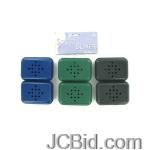
| Updated Blogs |
|
Computer Support Blog
Essensial Software for Web Based Support
HP Server and Desktop
HP ILO - Remote Tech-Support Software
More .....
|
 RSS Feed | Login
RSS Feed | Login http://www.akkukaufen.com
Akku kaufen, Notebook/Laptop Akkus und Adapter /Netzteil - akkukaufen.com
Apple MacBook 13 inch Battery www.all-laptopbattery.com
By vorinstalliert at 2017-12-03 01:00:14
“Oh sorry, I forgot to reconnect the audio cable,” he apologises jovially. “That must have been the most boring thing ever!”When it comes to question time, a microphone is passed around the audience. We can hear each question very distinctly through our headphones. Unfortunately, the demonstrator can’t: his headset mic isn’t picking up our audio, so he borrows one of our headphones … but these don’t have a mic. In the end, he is forced to wear two headsets at the same time, like a Shoreditch hipster nightclub had accidentally hired a demented Steampunk Cyberman to DJ for the night.None of this, however, compares with his chosen subject matter itself: Augmented Reality. He was asking for trouble, surely, by volunteering to talk about tech that is complete and utter bollocks. In a series of little demos, we got to see lots of glitchy examples of dire little graphics that pop up and promptly go weird or fall apart, while bearing all the convincing 3D realism of the set design in Wolfenstein.Augmented, I remind readers, means to be improved or made greater by having something added to it. How exactly does obscuring 3D reality with a wobbly stack of unconvincingly skinned primitives, only viewable through a limited two-dimensional flat screen and only controllable via two-dimensional gestures, count as an augmentation?
This bloke was right: Augmented Reality is not just a bad name, it’s a complete misnomer, and is ripe for renaming. However, he can stick XXooming up his arse, or should I say, allow it to tumble down his hole, preferably with the flashlight to keep it in place.I was thinking more along the lines of Obscured Reality, or perhaps Poorly Implemented Overlay Tech, or even Over-Complicated Flat Alternative to Showing You Legible Information by Getting in the Way of Actual Reality.Let’s settle on Jittery Implementation of Shell Models. I look forward to ex-AR developers producing their JISM in front of audiences in future. Break out the screen-wipes. Serif has offered Windows-based alternatives to Adobe’s graphics and DTP software for as long as anyone can remember, but last year it broke into the Mac market with Affinity Designer, a very good new vector drawing app. The next part of its planned suite is Affinity Photo, now in public beta. New builds are being notified every few days, so you may not see exactly the same product featured here.
At around 500MB, Affinity is two-thirds lighter than Photoshop but feels comprehensive and extremely responsive. Photoshop plugins are supported and most Photoshop key shortcuts are matched, although I was thwarted by the square bracket shortcuts working only for brush size, not softness.Raw images are processed in Affinity Photo’s Develop module, which includes manual distortion corrections as well as a full range of tonal adjustments – click for a larger image
Besides the main Photo mode there are three other ‘Personas’, toggled via buttons at the top left: Liquify, emulating Photoshop’s freehand distortion module of the same name; Export, which supports slicing; and Develop. The latter appears to allow pre-processing when you open a raw image, but will ultimately be available for general editing too.Layer support extends to adjustment layers and ‘live filters’, similar to Photoshop’s Smart Filters. Masks are applied as linked layers, and vector paths can be treated the same way. It’s an extremely versatile system once you get the hang of it. At the moment, Shadows/Highlights doesn’t work as well as the Photoshop equivalent. It’s impossible to know what will and won’t be fixed in the finished app, but the regularly updated public beta shows willing.
- Apple MacBook 13 inch Battery
- Apple iBook G4 12inch Battery
- Apple 13 inch MacBook Air Battery
- Apple PowerBook G4 15inch Battery
- Apple MacBook Pro 17inch Battery
- Apple MacBook Pro 15 Battery
- Apple MacBook Pro 15.4 Battery
- Apple MacBook Pro 13inch Battery
- Apple PowerBook G4 15 inch Battery
- Apple PowerBook G4 12inch Battery
- Apple MacBook Pro 17 Battery
- Apple MacBook Pro 15 inch Battery
- Apple MacBook Pro 13 inch Battery
- Apple Macbook Air 13 inch Battery
- Apple MacBook Air 13.3 Battery
- Apple PowerBook G4 17inch Battery
- Apple PowerBook G4 15inch Titanium Battery
- Apple PowerBook G4 15 A1106 Battery
Adjustments and filters can be applied non-destructively using the versatile layer system – click for a larger image
I found Affinity’s Selection Brush as good as Photoshop’s, and the Refine Selection tool seems promising, although it tends to stop for long thinks. There are direct equivalents of Photoshop’s Clone Stamp, Healing Brush and Patch tools, plus the Inpainting Brush, a cross between Content-Aware Fill (in that it doesn’t work in real time) and the Spot Healing Brush.Both CMYK and Lab colour spaces are supported for those who prefer them, as well as 16-bit editing. And frequency separation, a technique popular for skin retouching which requires some manual layer-juggling in Photoshop, is supported in Affinity by a very usable dedicated feature. It’s enough to make you think Serif might actually have bothered to ask pro photo editors what they do all day. If other software makers start doing this, anything could happen.Frequency Separation splits the image into two layers, one containing the fine detail and the other the colour information, so you can edit them independently. It’s often used for skin retouching – click for a larger image
On the other hand, pros need a way of organising their photos, and Affinity doesn’t address that; there are no management or batch processing features, and no sign of macros or scripting. Photoshop plugins, or some of them, will be supported, and numerous annoyances are eliminated by the clever Assistant options, which automatically do whatever you would need to do to avoid an operation showing an error alert, instead of showing the error alert.In terms of photo editing alone, Affinity Photo looks like a strong competitor for Photoshop at a great price, not because it tries to copy the most features but because it gets the important ones right. A Windows version could appear in the future.The concept of usability for a data centre sounds a bit bonkers, but actually it's a crucial consideration. I've come across data centres – particularly in big UK cities – that were dark, gloomy, hard to navigate and entirely devoid of equipment, as well as being a bloody nightmare to get to.A good data centre will be well lit. Although you should have a torch to hand to see into the darker recesses of your cabinets, for general work you should be expect to be able to see what is going on.The aisles between the cabinets need to be sensibly sized – so that you're not squeezing yourself down narrow gaps carrying big servers and the like – and it should be easy to remove the doors of the cabinets for ease of access.
There should be appropriate step stools and ladders available, so you can safely access the higher bits of your cabinets without the need to bring your own ladder.There should be a stock of basic tools you can borrow (screwdrivers, wire cutters and the like) so that you can do what you need to if you're on a call-out and you've not been able to get back to base to collect your toolbag.Decent data centres have “crash carts” – trolleys with keyboard, mouse and monitor that you can use in the event that your KVM shelf decides to go a bit wrong – and you should be able to cadge Ethernet and power cables in the event that you need such a thing in a rush.Next, a build area should be available. Decent data centres don't let you take boxed kit into the hosting area, because it's both a fire risk and a pain to work with in a busy hosting areas.So there should be a convenient area in which you can unbox stuff and run it up on a workbench, along with suitable disposal facilities for the packaging.A quiet area is also a must. Data centres are noisy, nasty places to be if you're trying to concentrate on working out a problem, and you must be able to escape to somewhere quiet.If there's a refreshment area, that's great too: I once spent 11 hours in a Philadelphia data centre on an overnight conference call doing a global network change, and the availability of somewhere quiet that had an endless supply of half-decent coffee made a big difference.
- Apple MacBook Unibody 13 Battery
- Apple MacBook Pro Unibody 15 Battery
- Apple Macbook Pro 17 A1151 Battery
- Apple MacBook Pro 15 A1286 (Mid-2010) Battery
- Apple MacBook Pro 15 A1286(2011&2012 Version) Battery
- Apple MacBook Pro 15 A1286 (2009 Version) Battery
- Apple MacBook Pro 15 A1286 (2008 Version) Battery
- Apple MacBook Pro 13inch Precision Aluminum Unibody 2009-2010 Battery
- Apple MacBook Pro 13 Battery
- Apple MacBook Air Core i7 13 (Mid-2013) Battery
- Apple MacBook Air Core i5 13 (Mid-2013) Battery
- Apple MacBook Air 13.3-inch Battery
- Apple Macbook Air 13.3 A1496 (2013 Version) Battery
- Apple Macbook Air 13.3 A1466 (2013 Version) Battery
- Apple MacBook Air 11 A1465 (2013 Version) Battery
- Apple Macbook Air 11 A1465 (2012 Version) Battery
- Apple iBook G4 14inch Battery
- Apple iBook G3 14inch Battery
Finally, it's great if they have a “guest” internet connection, either in the quiet area or in the data centre. If your internet router's just died and you need to download the firmware image, this will save your bacon (and it'll also mean you can connect your laptop to the net just for general stuff like email without having to plug it into your nice, secure hosted set-up).Review Like or loathe Chromebooks, the marque offers security and convenience at an affordable price. And for the most part they are lightweight with a touch of style. Up until now Chromebooks had a monopoly on that combination but HP has cooked up some competition with its Stream Cloud range of budget Windows machines.At the moment there are three models in the range. Two are conventional laptops, an 11.6-inch model costing £180 and a 13.3-incher costing £230. The third is a 11.6-inch convertible, again costing £230.Under the hood, the three machines are much the same and it’s the 11.6-inch convertible, the Stream x360, that I’m poking with the Reg stick today.
The obvious and immediate appeal of the HP x360 is visual. The graduated aquamarine colour scheme on the keyboard deck is rather fetching and the same goes for the matt finish Tory blue used everywhere else. The HP x360 scores more aesthetic points for not trying to look like a knock-down MacBook and not being plastered with stickers.Granted, it is all a bit plastic but what do you expect for this sort of money? HP deserves a pat on the head for realising that making a machine cheap and cheerful is fine just so long as it is cheap and very cheerful. At 1.55kg and 308 x 215 x 22mm this new HP is also a reasonably light and slender offering.All that plastic hasn't had any overly deleterious effects on how the HP x360 Stream feels when you manhandle it. The keyboard deck is solid and the lid has no more flex to it than you would expect of any machine not made of aluminium or magnesium.
Permalink | Comments (0)
Comments
To add a comment please login by clicking here




